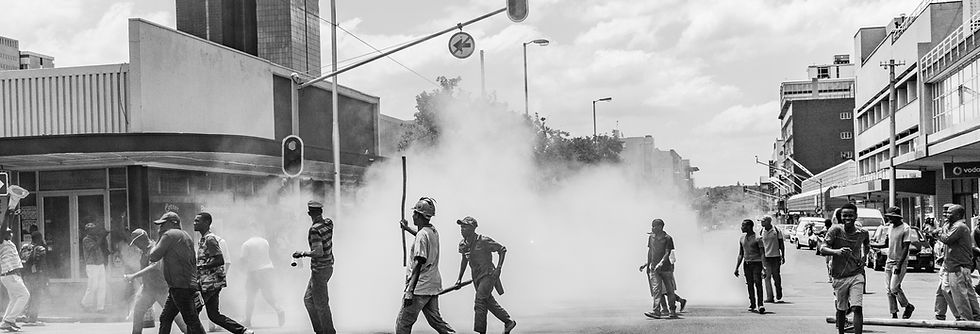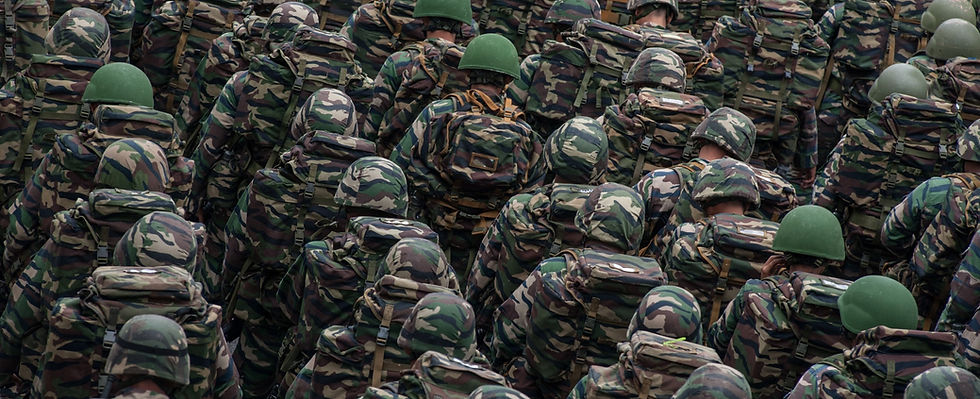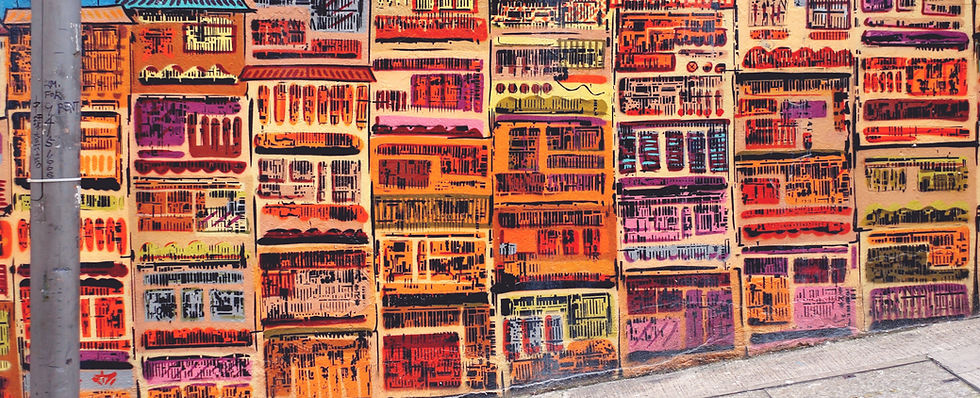ChrisDickson
Activism and Art in Children of Men
When asked how much the revolution is worth to him, social activist Abbie Hoffman replied simply, “My life.” This philosophy of activism is often reflected in art, especially in film. Potentially the blueprint for this value in film is Alfonso Cuarón’s Children of Men, in which the protagonist Theo is pulled back into his old life of activism and in the end, gives his life to the revolution. The film revolves around activism and Alfonso Cuarón’s recreation of many famous artworks in the film which their meaning goes right along with Imre Szeman’s essay titled “Art, Activism, and the Politics of Pipelines” where he discusses how art opens us into the reality in which we live in. Both the film and essay discuss activism and art in a way that showcases how the two go hand in hand when it comes to fighting for what's right by showing the harsh reality in which we live and offering hope.

The opening shot of Children of Men immediately establishes the hopelessness of the world we the audience are about to embark in. The youngest person in the world has just died and everyone in a coffee shop is frozen, eyes glued to the screen as they watch the news. We are then pushed into the outside world, it is gray, dull, lifeless, and just as you think things couldn't get any worse BOOM, the coffee shop is blown up. The opening scene is not only shocking but eerily similar to the world we live in. We all find ourselves staring at our television or phone screens frozen in hopelessness as we watch the world unfold. How can we possibly feel any hope in a world where it seems everything is collapsing? This feeling of hopelessness is exactly where art and activism come in.
Activism comes in many different forms, and how we show support is constantly changing, as Imre Szeman writes, “The shape and space of political action changes constantly. What might have worked to challenge sites and networks of power at one moment might prove impotent in another (49).” The film Children of Men touches on this idea as well as the protagonist Theo used to be a social activist, however as time went on the activism he is now a part of is not just protesting on the streets but rather a large-scale operation with hideouts and even weapons. Both the film and essay show that a reason for this is due to more militarized streets and government oppression. Szeman adds to this by stating, “But the streets occupied by protesters today have changed in myriad ways. The rise of neoliberalism and the carceral state have transformed cities into more managed and militarized spaces, more dangerous and surveilled than the plotted, planned landscape the Situationists had hoped to unnerve (49).” Activism often frightens the ones in power and leads to heavy control of when and where activism can happen. This leads to activists having limited spaces to go and less visibility to the world. With nowhere to go and nowhere to be seen, this is where art becomes a part of the revolution.

Throughout Children of Men, two elements are consistently shown throughout the film, military and art. Graffiti is in the background of almost all of the city and refugee camp shots, often in the background while the militaristic powers are in the foreground. When there is no place to actively protest graffiti or slogans have often been a form of activism in its place. In Szeman’s essay, he discusses how in protest of pipelines people have put up art with slogans so people can begin,”... visualizing otherwise hidden pipeline infrastructure, by situating art-covered mobile homes along its route (52).” This allows people to visualize oppression in a way that they may have not seen. The art evokes an emotion in the viewer to see more clearly what is being fought for and turns the message into a more easy to understand meaning. Both the essay and film show how when given no other options, art is a way in which people revolt against the system to visualize their emotions and the revolution's meaning in a more digestible way for viewers.
Visualizing the revolution through art doesn’t just make a more digestible message for the viewer but also inspires hope. Children of Men shows this by recreating famous works of art in the film, such as having Kee stand in the same position as Sandro Botticelli’s “The Birth of Venus”. Before that scene, Theo is unsure of the activists at the time, even asking Jasper when discussing the Human Project, “Human Project, why do people believe this crap?” However, after seeing that Kee is pregnant, while he stands in the pose of “The Birth of Venus” he now sees the vision. As discussed earlier, at the beginning of the film everyone’s eyes are glued to the television, frozen in shock, horror, and hopelessness while Theo goes on with his day, but now Theo is the one frozen with the realization that there is hope. The film shows how art can inspire and give hope by recreating famous artworks in the film. By doing this we can see the artwork in a physical form, making us see how art truly does mimic real life.

The film has a heavy focus on how to gain hope in hopeless times with art being just one of the many ways to explore that theme, yet Szenman’s essay takes a different approach, exploring how art arrives from hopelessness to show the harsh reality in which we live in. In relation to the artwork surrounding pipeline activism, he writes that “the point is that artists in Canada have engaged determinately in the task of exploring and critiquing the fantasies of wealth and the environmental horrors that have accompanied the expansion of energy extraction in the country (51).” He is attempting to show how the art arrives from a place of hopelessness that breeds art that highlights the atrocities being committed. Though as stated before Children of Men is mainly focused on the theme of hope, it certainly does not shy away from showing the dark side of art as well. Early in the film while Theo is taking a train, words are spray painted on a wall that says, “Last one to die please turn out the light.” In a world where everyone is infertile, this slogan is extremely grim, yet highlights how people are expressing the hopelessness they feel. Similar to the posing of Sandro Botticelli’s “The Birth of Venus”, later in the film, a mother is crying holding her dead son, again a recreation of famous artwork, Michelangelo’s “La Pietà”. This reference to art, unlike “The Birth of Venus” does not inspire hope, instead shows the grim world we live in and the horrors of war. The artworks shown in Szeman’s essay and Children of Men are not just grim to be grim however, they motivate change by putting the reality of what is happening right in front of you. When putting hope and motivation together, real change is inspired and created.
Though the artworks may be motivating to the people, the political powers are not so easy to sway. Szeman writes “All things being equal, however, it has to be said that such art practices have (unfortunately) had a limited impact on either public consciousness or policy debates.” Not all hope is lost however as active protesting is still proven to have a larger impact on political discourse. Larger scale protests gain a lot of media attention so what is happening can be seen by a broader audience, in turn making the public more aware (Szeman 51). Though the artwork is inspiring and gives hope for a better world, Theo in Children of Men simply says, “Make it public”. Media attention is everything and can change everything. This was shown in the film with a long shot in which both sides stopped fighting when seeing the baby Kee has given birth to. This is one of the most powerful moments in the film as for a second when the baby is in sight all the bullets stop raining down on each other as two sides come together to see the baby and remember their shared goal. Bringing to light the matter hands on is exactly what Szeman discusses in his essay, it forces you to see exactly what is happening and what is at stake. By being at pipelines, blocking roads, or showing up at government officials' doorsteps, it forces the ones in power to address and react to the movement.
This does not mean however that art does not have an impact on activism. In many cases, activists are arrested or places of activism are heavily watched and militarized. Szeman discusses this stating that “Artists have often participated in these protests; some, including artists Pia Massie and Susan Smyth, and poets Stephen Collis and Rita Wong, have been arrested for their opposition to the expansion of pipelines from land-locked Alberta to the west coast of Canada (51).” Much oppression is shown in Children of Men such as this but an even better comparison is how after the oppression, the oppressors attempt to convince the public that everything is perfectly fine through the use of propaganda. Szeman gives examples of Canada trying to spread the word that the oil is “ethical” and okay to use (Szeman 53). A similar tactic is used in Children of Men, there is constant propaganda in the city, a train even replays a message on a screen showing the world burning, countries collapsing, and ending by stating, “The world has collapsed, only Britain soldiers on.” This nationalism and propaganda is exactly why art is so important in activism, both the essay and film show how while being oppressed art is a light that shows the world what is happening. It is a form of expression in bleak times that reminds us all we are not alone in the revolution and criticizes the ones in power when there is no other way to.

Fighting the good fight throughout the course of human history has been a struggle. Oppressors always attempt to shut protests down with force and silence the oppressed but no matter what, art has always stood strong in the fight against oppression. Imre Szeman’s essay titled “Art, Activism, and the Politics of Pipelines” and Alfonso Cuarón’s Children of Men both show how in times of darkness, art is a beacon of hope in an often hopeless world. When putting the film and essay together, it helps us understand better the relationship between art and activism. Children of Men taking place in a science fiction world can for some forget how much the film has relevance today, but when put with Szeman’s essay, the meaning becomes much more clear. The two share a similar dialogue and meaning that activism and art when put together create an experience for the viewer where they are forced to see what is unfolding in front of them.